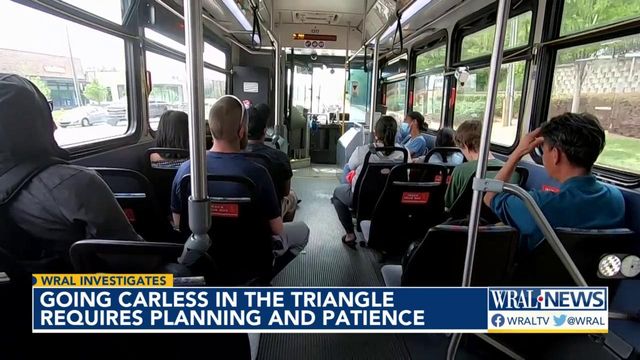Going carless in the Triangle requires planning, patience
As public transit ridership in the Triangle makes a post-pandemic rebound, passengers continue to express frustration over the frequency and reliability of bus service.
Reese Wright recently moved to Raleigh from Baltimore and relies on GoRaleigh to get around daily. She often times gets to the bus stop an hour early after numerous experiences with busses that either did not come or arrived late.
“It’s frustrating,” Wright said. “It eventually does come but sometimes it’s unpredictable, from 20 minutes to an hour and a half late.”
The region’s tremendous growth has the North Carolina Department of Transportation working on more than 20 major road projects. But with 64 people moving to the Triangle everyday, according to the Research Triangle Regional Partnership, transit advocates stress the need for greater spending on public transportation infrastructure.
“We cannot build more roads to get out of congestion,” said Mary-Jo Gellenbeck, a member of Raleigh’s Bicycle and Pedestrian Advisory Board.
Gellenbeck, who lives close to three transit lines in Five Points, started riding GoRaleigh as an experiment after totaling her car. While she eventually mastered her routes, she initially found the system stressful to navigate.
“You have to know the route and learn it a lot,” she said. “I could not recruit any of my neighbors to join me in this experiment.”
GoRaleigh’s wait times currently range from 15 to 60 minutes depending on the time and day.
Advocates say more frequent service — every 6 to 10 minutes — could convince more people to ride instead of drive.
“You know you don’t have to wait for the bus to arrive,” Gellenbeck said.
Mayor Mary-Ann Baldwin said she supports increasing the frequency of bus service and the construction of a commuter rail line.
“They need frequency and reliability,” Baldwin said. “I want people to have a good experience when they are riding the bus to understand this is a viable option for them.”
The latest data shows the current on-time performance for the Triangle’s transit systems:
- GoRaleigh: 84%
- GoDurham: 85%
- GoTriangle: 83%
- GoCary: 95%
“The number one improvement that I would say could be made is the consistency,” said Daryl Kennedy, a longtime rider of GoRaleigh’s Six Forks Road route.
“There are improvements to be made and I do honestly feel they are doing that.”
GoRaleigh recorded more than 3.1 million trips in 2019. Ridership took a nosedive during the pandemic and has still not returned to pre-pandemic levels. Last year, the 2.6 million trips represented a 16% decrease in demand.
GoDurham reports similar declines. In February, the 443,078 trips represented a 14% decrease from 515,489 trips in February 2019.
A bus driver shortage has forced transit systems in recent years to scale back service. Facing a shortage of 30 bus operators, GoRaleigh reduced the frequency of service on 11 routes last September. Seven months later, GoRaleigh is still short 30 operators.
GoDurham has 20 bus driver vacancies and GoTriangle is working to hire 27 drivers.
“It goes against every principle that we have in trying to get people to come out and ride the bus," said David Walker, a GoRaleigh transportation supervisor in September.
Baldwin admits it would be hard for someone to ditch their car in Raleigh if they do not live near a transit corridor.
When asked if a resident moving from outside the area would need a car in Raleigh, Baldwin said, “It depends where you live and where you are going.”
By 2025, the city of Raleigh plans to open its first Bus Rapid Transit (BRT) line on New Bern Avenue with service every 10 minutes. Three more BRT lines will be built over the next 12 years.
GoTriangle is exploring a 40-mile commuter rail line that extends from Clayton to Durham and connects employment hubs, downtowns, universities, medical centers and residential areas. The cost is estimated at $3 billion.
“We have to be fully committed to regional rail,” Baldwin said. “It’ll be healthy, it’s healthier for our environment and it will eliminate future problems.”
Riders interested in learning more about current routes can visit GoRaleigh, GoDurham, GoTriangle and GoCary online.












